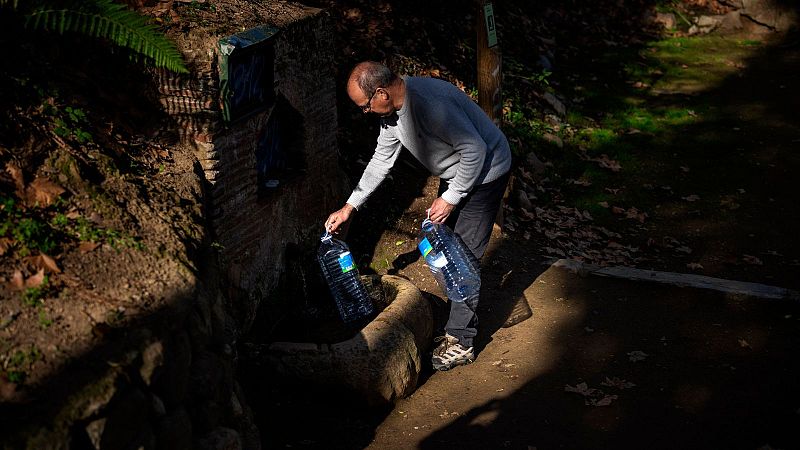
“Girls pulled from school and forced into marriage, hospitals going dark, and families digging holes in dry riverbeds just to find contaminated water - these are signs of severe crisis," says Paula Guastello, drought impacts researcher at the US National Drought Mitigation Center (NDMC).
Together with the UN Convention to Combat Desertification (UNCCD), the US centre has just finished surveying global droughts between 2023 to 2025. They found that some of the most widespread and damaging droughts in recorded history have hit during the last two years.
Their new report gathers information from hundreds of government, scientific and media sources to highlight the most acute drought hotspots around the world, including in the Mediterranean.
Around 35 per cent of the EU and UK fell under a form of drought warning in early June, according to the latest official data, following a record-breaking hot spring driven by climate change. Alert conditions are intensifying in large areas of Ukraine, in some parts of Türkiye, as well as in the UK, Poland, Cyprus, Greece, and the south-eastern Balkans.
“Drought is a silent killer. It creeps in, drains resources, and devastates lives in slow motion. Its scars run deep,” says UNCCD Executive Secretary Ibrahim Thiaw.
“It is here, escalating, and demands urgent global cooperation. When energy, food, and water all go at once, societies start to unravel. That’s the new normal we need to be ready for.”
Where are Europe's drought hotspots?
Spain, Morocco and Türkiye are bearing the brunt of drought in the Mediterranean, the report confirms.
Water shortages have hit Spain’s agriculture and tourism sectors hard in recent years. By September 2023, two years of drought and record heat led to a 50 per cent drop in Spain’s olive crop, causing its olive oil prices to double across the country.
Meanwhile, in Türkiye, drought has accelerated groundwater depletion, triggering sinkholes that endanger local residents and their infrastructure. It also permanently reduces aquifer storage capacity.
“The Mediterranean countries represent canaries in the coal mine for all modern economies,” says Dr Mark Svoboda, report co-author and NDMC director.
“The struggles experienced by Spain, Morocco and Türkiye to secure water, food, and energy under persistent drought offer a preview of water futures under unchecked global warming. No country, regardless of wealth or capacity, can afford to be complacent.”
Far from being “a dry spell”, Dr Svoboda adds, “This is a slow-moving global catastrophe, the worst I've ever seen.”
Why drought is ‘not just a weather event’
Given the way drought compounds poverty, hunger and energy insecurity, the most devastating hotspots are found outside of Europe, in some of the world’s poorest countries.
More than 90 million people across Eastern and Southern Africa face acute hunger, according to the report, where some areas have been enduring their worst-ever recorded drought.
In Somalia, the government estimated that 43,000 people died in 2022 alone due to drought-linked hunger.
Zambia suffered one of the world's worst energy crises in April 2024 as the Zambezi River plummeted to levels that are 20 per cent of its long-term average. The country’s largest hydroelectric plant, the Kariba Dam, fell to 7 per cent generation capacity, causing blackouts of up to 21 hours per day, forcing hospitals, bakeries, and factories to close.
“Drought is not just a weather event - it can be a social, economic, and environmental emergency,” stresses report co-author Dr Kelly Helm Smith, NDMC assistant director and drought impacts researcher.
In Eastern Africa, forced child marriages more than doubled as families sought dowries to survive. Though outlawed in Ethiopia, child marriages more than doubled in frequency in the four regions hit hardest by the drought.
Across the world in the Amazon, the drought upended life for remote Indigenous and rural communities. In some areas, the river fell to its lowest level ever recorded, leaving residents stranded - including women giving birth - and entire towns without drinking water.
It is a common theme that drought takes a disproportionate toll on women and children.
“The coping mechanisms we saw during this drought grew increasingly desperate,” says Guastello.
Climate change and El Nino are creating ‘perfect storm’
Between 2023 to 2024, an El Niño climate phenomenon amplified already harsh climate change impacts, the researchers explain, triggering dry conditions across major agricultural and ecological zones.
“This was a perfect storm,” says report co-author Dr Smith. “El Niño added fuel to the fire of climate change, compounding the effects for many vulnerable societies and ecosystems past their limits.”
The report makes several recommendations to alleviate the impact of droughts, including: stronger early warning systems to save lives; nature-based solutions like watershed restoration; off-grid energy infrastructure; and gender responsive adaptation.
“The nations of the world have the resources and the knowledge to prevent a lot of suffering,” Dr Smith adds. “The question is, do we have the will?”







